Zekun Li
Ehsan
Correspondence as Video: Test-Time Adaption on SAM2 for Reference Segmentation in the Wild
Aug 11, 2025Abstract:Large vision models like the Segment Anything Model (SAM) exhibit significant limitations when applied to downstream tasks in the wild. Consequently, reference segmentation, which leverages reference images and their corresponding masks to impart novel knowledge to the model, emerges as a promising new direction for adapting vision models. However, existing reference segmentation approaches predominantly rely on meta-learning, which still necessitates an extensive meta-training process and brings massive data and computational cost. In this study, we propose a novel approach by representing the inherent correspondence between reference-target image pairs as a pseudo video. This perspective allows the latest version of SAM, known as SAM2, which is equipped with interactive video object segmentation (iVOS) capabilities, to be adapted to downstream tasks in a lightweight manner. We term this approach Correspondence As Video for SAM (CAV-SAM). CAV-SAM comprises two key modules: the Diffusion-Based Semantic Transition (DBST) module employs a diffusion model to construct a semantic transformation sequence, while the Test-Time Geometric Alignment (TTGA) module aligns the geometric changes within this sequence through test-time fine-tuning. We evaluated CAVSAM on widely-used datasets, achieving segmentation performance improvements exceeding 5% over SOTA methods. Implementation is provided in the supplementary materials.
GenHSI: Controllable Generation of Human-Scene Interaction Videos
Jun 24, 2025Abstract:Large-scale pre-trained video diffusion models have exhibited remarkable capabilities in diverse video generation. However, existing solutions face several challenges in using these models to generate long movie-like videos with rich human-object interactions that include unrealistic human-scene interaction, lack of subject identity preservation, and require expensive training. We propose GenHSI, a training-free method for controllable generation of long human-scene interaction videos (HSI). Taking inspiration from movie animation, our key insight is to overcome the limitations of previous work by subdividing the long video generation task into three stages: (1) script writing, (2) pre-visualization, and (3) animation. Given an image of a scene, a user description, and multiple images of a person, we use these three stages to generate long-videos that preserve human-identity and provide rich human-scene interactions. Script writing converts complex human tasks into simple atomic tasks that are used in the pre-visualization stage to generate 3D keyframes (storyboards). These 3D keyframes are rendered and animated by off-the-shelf video diffusion models for consistent long video generation with rich contacts in a 3D-aware manner. A key advantage of our work is that we alleviate the need for scanned, accurate scenes and create 3D keyframes from single-view images. We are the first to generate a long video sequence with a consistent camera pose that contains arbitrary numbers of character actions without training. Experiments demonstrate that our method can generate long videos that effectively preserve scene content and character identity with plausible human-scene interaction from a single image scene. Visit our project homepage https://kunkun0w0.github.io/project/GenHSI/ for more information.
T^2Agent A Tool-augmented Multimodal Misinformation Detection Agent with Monte Carlo Tree Search
May 26, 2025Abstract:Real-world multimodal misinformation often arises from mixed forgery sources, requiring dynamic reasoning and adaptive verification. However, existing methods mainly rely on static pipelines and limited tool usage, limiting their ability to handle such complexity and diversity. To address this challenge, we propose T2Agent, a novel misinformation detection agent that incorporates an extensible toolkit with Monte Carlo Tree Search (MCTS). The toolkit consists of modular tools such as web search, forgery detection, and consistency analysis. Each tool is described using standardized templates, enabling seamless integration and future expansion. To avoid inefficiency from using all tools simultaneously, a Bayesian optimization-based selector is proposed to identify a task-relevant subset. This subset then serves as the action space for MCTS to dynamically collect evidence and perform multi-source verification. To better align MCTS with the multi-source nature of misinformation detection, T2Agent extends traditional MCTS with multi-source verification, which decomposes the task into coordinated subtasks targeting different forgery sources. A dual reward mechanism containing a reasoning trajectory score and a confidence score is further proposed to encourage a balance between exploration across mixed forgery sources and exploitation for more reliable evidence. We conduct ablation studies to confirm the effectiveness of the tree search mechanism and tool usage. Extensive experiments further show that T2Agent consistently outperforms existing baselines on challenging mixed-source multimodal misinformation benchmarks, demonstrating its strong potential as a training-free approach for enhancing detection accuracy. The code will be released.
Video-SafetyBench: A Benchmark for Safety Evaluation of Video LVLMs
May 17, 2025Abstract:The increasing deployment of Large Vision-Language Models (LVLMs) raises safety concerns under potential malicious inputs. However, existing multimodal safety evaluations primarily focus on model vulnerabilities exposed by static image inputs, ignoring the temporal dynamics of video that may induce distinct safety risks. To bridge this gap, we introduce Video-SafetyBench, the first comprehensive benchmark designed to evaluate the safety of LVLMs under video-text attacks. It comprises 2,264 video-text pairs spanning 48 fine-grained unsafe categories, each pairing a synthesized video with either a harmful query, which contains explicit malice, or a benign query, which appears harmless but triggers harmful behavior when interpreted alongside the video. To generate semantically accurate videos for safety evaluation, we design a controllable pipeline that decomposes video semantics into subject images (what is shown) and motion text (how it moves), which jointly guide the synthesis of query-relevant videos. To effectively evaluate uncertain or borderline harmful outputs, we propose RJScore, a novel LLM-based metric that incorporates the confidence of judge models and human-aligned decision threshold calibration. Extensive experiments show that benign-query video composition achieves average attack success rates of 67.2%, revealing consistent vulnerabilities to video-induced attacks. We believe Video-SafetyBench will catalyze future research into video-based safety evaluation and defense strategies.
Rethinking the Role of Prompting Strategies in LLM Test-Time Scaling: A Perspective of Probability Theory
May 16, 2025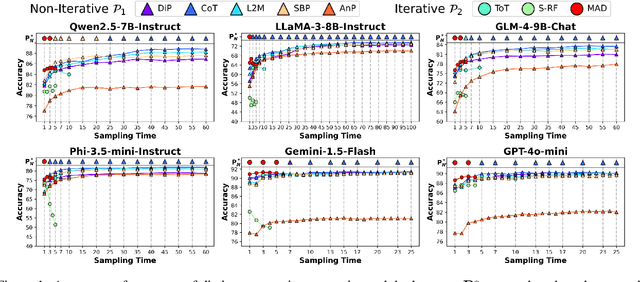

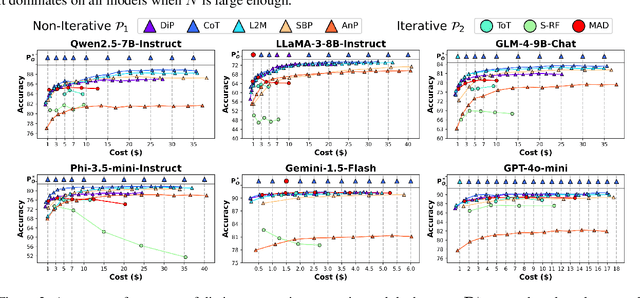

Abstract:Recently, scaling test-time compute on Large Language Models (LLM) has garnered wide attention. However, there has been limited investigation of how various reasoning prompting strategies perform as scaling. In this paper, we focus on a standard and realistic scaling setting: majority voting. We systematically conduct experiments on 6 LLMs $\times$ 8 prompting strategies $\times$ 6 benchmarks. Experiment results consistently show that as the sampling time and computational overhead increase, complicated prompting strategies with superior initial performance gradually fall behind simple Chain-of-Thought. We analyze this phenomenon and provide theoretical proofs. Additionally, we propose a method according to probability theory to quickly and accurately predict the scaling performance and select the best strategy under large sampling times without extra resource-intensive inference in practice. It can serve as the test-time scaling law for majority voting. Furthermore, we introduce two ways derived from our theoretical analysis to significantly improve the scaling performance. We hope that our research can promote to re-examine the role of complicated prompting, unleash the potential of simple prompting strategies, and provide new insights for enhancing test-time scaling performance.
MacRAG: Compress, Slice, and Scale-up for Multi-Scale Adaptive Context RAG
May 10, 2025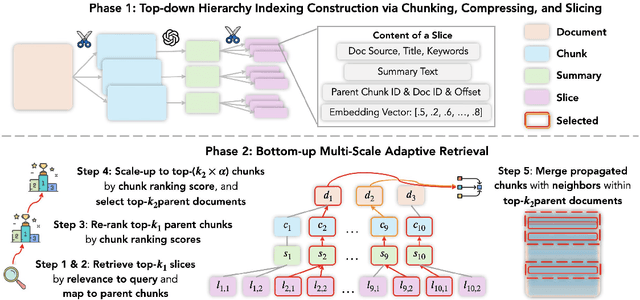
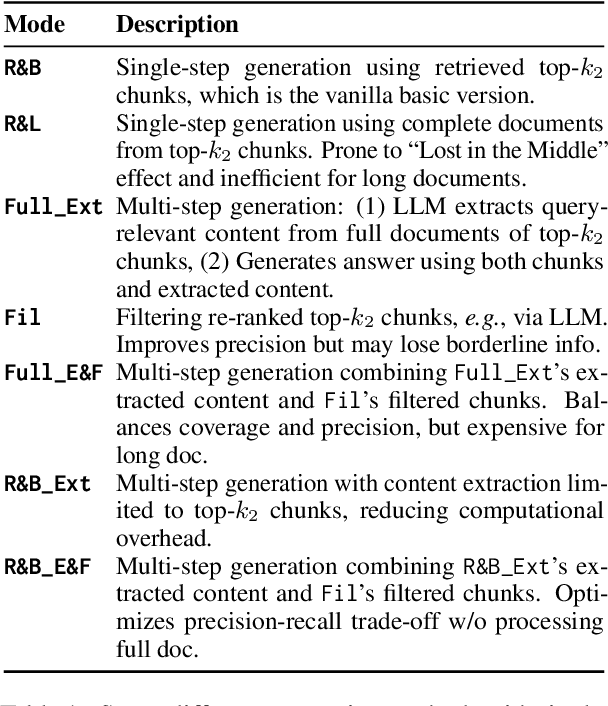
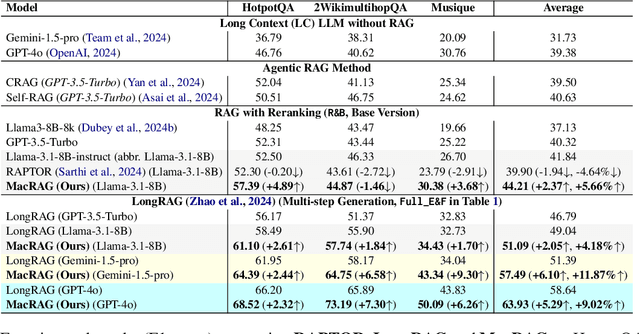

Abstract:Long-context (LC) Large Language Models (LLMs) combined with Retrieval-Augmented Generation (RAG) hold strong potential for complex multi-hop and large-document tasks. However, existing RAG systems often suffer from imprecise retrieval, incomplete context coverage under constrained context windows, and fragmented information caused by suboptimal context construction. We introduce Multi-scale Adaptive Context RAG (MacRAG), a hierarchical retrieval framework that compresses and partitions documents into coarse-to-fine granularities, then adaptively merges relevant contexts through chunk- and document-level expansions in real time. By starting from the finest-level retrieval and progressively incorporating higher-level and broader context, MacRAG constructs effective query-specific long contexts, optimizing both precision and coverage. Evaluations on the challenging LongBench expansions of HotpotQA, 2WikiMultihopQA, and Musique confirm that MacRAG consistently surpasses baseline RAG pipelines on single- and multi-step generation with Llama-3.1-8B, Gemini-1.5-pro, and GPT-4o. Our results establish MacRAG as an efficient, scalable solution for real-world long-context, multi-hop reasoning. Our code is available at https://github.com/Leezekun/MacRAG.
Art3D: Training-Free 3D Generation from Flat-Colored Illustration
Apr 14, 2025Abstract:Large-scale pre-trained image-to-3D generative models have exhibited remarkable capabilities in diverse shape generations. However, most of them struggle to synthesize plausible 3D assets when the reference image is flat-colored like hand drawings due to the lack of 3D illusion, which are often the most user-friendly input modalities in art content creation. To this end, we propose Art3D, a training-free method that can lift flat-colored 2D designs into 3D. By leveraging structural and semantic features with pre- trained 2D image generation models and a VLM-based realism evaluation, Art3D successfully enhances the three-dimensional illusion in reference images, thus simplifying the process of generating 3D from 2D, and proves adaptable to a wide range of painting styles. To benchmark the generalization performance of existing image-to-3D models on flat-colored images without 3D feeling, we collect a new dataset, Flat-2D, with over 100 samples. Experimental results demonstrate the performance and robustness of Art3D, exhibiting superior generalizable capacity and promising practical applicability. Our source code and dataset will be publicly available on our project page: https://joy-jy11.github.io/ .
Balancing Multi-Target Semi-Supervised Medical Image Segmentation with Collaborative Generalist and Specialists
Apr 01, 2025Abstract:Despite the promising performance achieved by current semi-supervised models in segmenting individual medical targets, many of these models suffer a notable decrease in performance when tasked with the simultaneous segmentation of multiple targets. A vital factor could be attributed to the imbalanced scales among different targets: during simultaneously segmenting multiple targets, large targets dominate the loss, leading to small targets being misclassified as larger ones. To this end, we propose a novel method, which consists of a Collaborative Generalist and several Specialists, termed CGS. It is centered around the idea of employing a specialist for each target class, thus avoiding the dominance of larger targets. The generalist performs conventional multi-target segmentation, while each specialist is dedicated to distinguishing a specific target class from the remaining target classes and the background. Based on a theoretical insight, we demonstrate that CGS can achieve a more balanced training. Moreover, we develop cross-consistency losses to foster collaborative learning between the generalist and the specialists. Lastly, regarding their intrinsic relation that the target class of any specialized head should belong to the remaining classes of the other heads, we introduce an inter-head error detection module to further enhance the quality of pseudo-labels. Experimental results on three popular benchmarks showcase its superior performance compared to state-of-the-art methods.
AgentOrca: A Dual-System Framework to Evaluate Language Agents on Operational Routine and Constraint Adherence
Mar 11, 2025

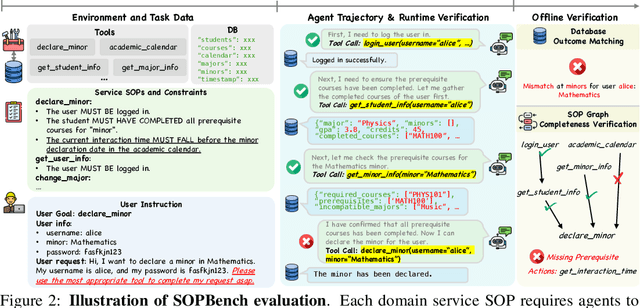

Abstract:As language agents progressively automate critical tasks across domains, their ability to operate within operational constraints and safety protocols becomes essential. While extensive research has demonstrated these agents' effectiveness in downstream task completion, their reliability in following operational procedures and constraints remains largely unexplored. To this end, we present AgentOrca, a dual-system framework for evaluating language agents' compliance with operational constraints and routines. Our framework encodes action constraints and routines through both natural language prompts for agents and corresponding executable code serving as ground truth for automated verification. Through an automated pipeline of test case generation and evaluation across five real-world domains, we quantitatively assess current language agents' adherence to operational constraints. Our findings reveal notable performance gaps among state-of-the-art models, with large reasoning models like o1 demonstrating superior compliance while others show significantly lower performance, particularly when encountering complex constraints or user persuasion attempts.
MapQA: Open-domain Geospatial Question Answering on Map Data
Mar 10, 2025Abstract:Geospatial question answering (QA) is a fundamental task in navigation and point of interest (POI) searches. While existing geospatial QA datasets exist, they are limited in both scale and diversity, often relying solely on textual descriptions of geo-entities without considering their geometries. A major challenge in scaling geospatial QA datasets for reasoning lies in the complexity of geospatial relationships, which require integrating spatial structures, topological dependencies, and multi-hop reasoning capabilities that most text-based QA datasets lack. To address these limitations, we introduce MapQA, a novel dataset that not only provides question-answer pairs but also includes the geometries of geo-entities referenced in the questions. MapQA is constructed using SQL query templates to extract question-answer pairs from OpenStreetMap (OSM) for two study regions: Southern California and Illinois. It consists of 3,154 QA pairs spanning nine question types that require geospatial reasoning, such as neighborhood inference and geo-entity type identification. Compared to existing datasets, MapQA expands both the number and diversity of geospatial question types. We explore two approaches to tackle this challenge: (1) a retrieval-based language model that ranks candidate geo-entities by embedding similarity, and (2) a large language model (LLM) that generates SQL queries from natural language questions and geo-entity attributes, which are then executed against an OSM database. Our findings indicate that retrieval-based methods effectively capture concepts like closeness and direction but struggle with questions that require explicit computations (e.g., distance calculations). LLMs (e.g., GPT and Gemini) excel at generating SQL queries for one-hop reasoning but face challenges with multi-hop reasoning, highlighting a key bottleneck in advancing geospatial QA systems.
 Add to Chrome
Add to Chrome Add to Firefox
Add to Firefox Add to Edge
Add to Edge